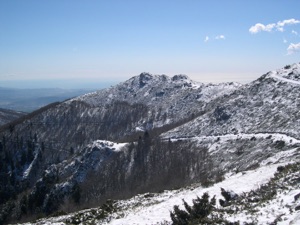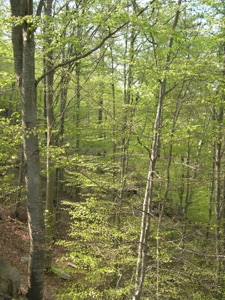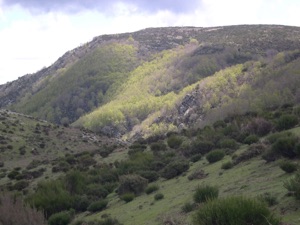Assessing the effects of climate change and habitat fragmentation on forest trees


Global climate change is one of the most important environmental issues of our time. The 20th century experienced the strongest warming trend of the last millennium with average temperatures rising about 0.6 degrees C - it is expected that future temperature rises will exceed this.
One of the predicted consequences of rising temperatures is the upward movement of plant species in mountain areas and their latitudinal movement toward the poles.
In mountain regions, a consequence of this movement is that the lower range margins of some species are receding and populations are shrinking, whilst populations are expanding at upper range limits. In some areas, large continuous populations are being reduced to smaller, isolated population fragments in refuges such as mountain tops.
This work assesses the effects of climate change and habitat fragmentation on temperate forest (dominated by European beech – Fagus sylvatica) in the Montseny Mountains of north east Spain, where recent evidence has shown an upward shift of the treeline by up to 70m in the last 50 years. We are also conducting comparable work in other beech forests in the region.

As part of this project we are investigating the effects of recent climate change on the growth and reproduction of European beech across its altitudinal range in this region. For example, we have identified that as the growth of this species is limited by high temperatures and drought at low altitudes, climate change is leading to a rapid reduction in growth at its lower altitudinal limit.
We are also looking at the impact of year-to-year variation in climate on the genetic structure of the population. Results so far indicate that some beech individuals within the forest possess an allele that is linked to a region of the genome that is favoured by cooler temperatures but not by warmer ones, the consequence being that different genotypes establish preferentially in different years as determined by climate.
Beech (Fagus sylvatica) forest
Particularly exciting is the evidence that current changes in climate are resulting in genetic changes in populations of this species. As the climate is warming, the frequency of this allele is decreasing within the population as natural selection favours those individuals in which it is absent. This genetic response to climate change isn't limited to F. sylvatica. An investigation of a long-term climate manipulation experiment nearby shows a similar response in the shrub Fumana thymifolia in response to selection imposed by elevated drought.
Our work F. sylvatica combines data from molecular markers with assessment of current trends in tree growth and establishment and their historic response to variation in the climate of the region. In some of the more ecological work, we've identified that reproduction of Fagus sylvatica is very low at its lower range-edge in comparison with its reproduction at higher altitudes. The evergreen oak Quercus ilex (holm oak) appears to be invading the F. sylvatica forest at low altitudes and is likely to result in the replacement of this temperate forest with more drought tolerant Mediterranean evergreen forest in some areas in the near future.
In some of our other work, we are investigating the effects of historic habitat fragmentation on the genetic structure and genetic diversity of remaining forest patches. We have found that fragmentation has led to a break up of the near 'panmictic' breeding system seen in continuous forest - forest fragments become more different from one another genetically as the distance between them increases, whereas continuous forest populations do not. Fragmented populations of F. sylvatica are also more inbred and lower in genetic diversity than their continuous forest counterparts - and this genetic decline appears to be ongoing.

Assessment of the responses of plants to environmental changes of the recent and more distant past allows us to make more accurate predictions of how they will respond to changes predicted for the future. Thus our work aims to increase our understanding of the possible responses of plant communities to some of the environmental changes that are yet to come.
Related publications
Peñuelas J, Sardans J, Estiarte M, Ogaya R, Carnicer J, Coll M, Barbeta A, Rivas-Ubach A, Lluisà J, Garbulsky M, Filella I, and Jump AS (2013). Evidence of current impact of climate change on life: a walk from genes to the biosphere. Global Change Biology 19, 2303-2338
Hampe A, Jump AS (2011). Climate relicts: past, present, future. Annual Review of Ecology, Evolution, and Systematics, 42, 313-333.
Barbeta A, Peñuelas J, Ogaya R, Jump AS (2011). Reduced tree health and seedling production in fragmented Fagus sylvatica forest patches in the Montseny Mountains (NE Spain). Forest Ecology and Management, 261, 2029-2037.
Bacles CFE, Jump AS (2011). Taking a tree’s perspective on forest fragmentation genetics. Trends in Plant Science, 16, 13-18.
Jump AS, Cavin L, Hunter P (2010). Monitoring and managing responses to climate change at the retreating range edge of forest trees. Journal of Environmental Monitoring, 12, 1791-1798.
Jump AS, Mátyás C, Peñuelas J (2009). The altitude-for-latitude disparity in the range retractions of woody species. Trends in Ecology and Evolution, 24, 694-701.
Jump AS, Marchant R, Peñuelas J (2009). Environmental change and the option value of genetic diversity. Trends in Plant Science, 14, 51-58.
Peñuelas J, Ogaya R, Hunt JM, Jump AS (2008). 20th century changes of tree-ring d13C at the southern range-edge of Fagus sylvatica. Increasing water-use efficiency does not avoid the growth decline induced by warming at low altitudes. Global Change Biology, 14, 1076–1088.
Peñuelas J, Ogaya R, Boada M, Jump AS (2007). Migration, invasion and decline: changes in recruitment and forest structure in a warming-linked shift of European beech forest in Catalonia (NE Spain). Ecography, 30, 830-838.
Jump AS, Hunt JM, Peñuelas J (2007). Climate relationships of growth and establishment across the altitudinal range of Fagus sylvatica in NE Spain. Ecoscience, 14, 507-518.
Jump AS, Peñuelas J (2007). Extensive spatial genetic structure revealed by AFLP but not SSR molecular markers in the wind-pollinated tree Fagus sylvatica. Molecular Ecology 16, 925-936.
Jump AS, Hunt JM, Martínez-Izquierdo JA, Peñuelas J (2006). Natural selection and climate change: Temperature-linked spatial and temporal trends in gene frequency in Fagus sylvatica. Molecular Ecology 15, 3469 - 3480.
Jump AS, Peñuelas J (2006). Genetic effects of chronic habitat fragmentation in a wind-pollinated tree. Proceedings of the National Academy of Sciences of the USA 103, 8096-8100.
Jump AS, Hunt JM, Peñuelas J (2006). Rapid climate change-related growth decline at the southern range-edge of Fagus sylvatica. Global Change Biology 12, 2163-2174.
Jump AS, Peñuelas J (2005). Running to stand still: adaptation and the response of plants to rapid climate change. Ecology Letters 8, 1010-1020.
Beech forest fragment in the Montseny Mountains